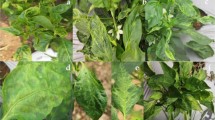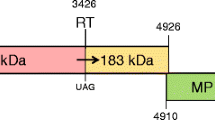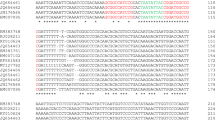Abstract
Cucumber mosaic virus (CMV) is one of the most important viral pathogen infecting several plant species in India. Five isolates of CMV obtained from cucumber, muskmelon, tobacco and tomato from distinct geographical locations in India were analysed based on host-reactions and genome sequence. The majority of the isolates were very similar and only two isolates, Tfr-In and Tss-In showed distinct symptoms in tomato and high sequence diversity (77.8%) in coat protein (CP) gene. Tfr-In was isolated from tomato fruit showing grey patches in Aurangabad and Tss-In from tomato plant showing shoe-string symptoms in New Delhi. The RNA-3 genomes of Tfr-In (2,214 nt; JF279606), shared only 70.3% nucleotide sequence identity with Tss-In (2,178 nt; JF279605. The complete RNA-3 genome of Tss-In and Tfr-In were compared with that of 65 CMV isolates reported from various plants of the world, which formed four distinct subclades-IA, -IB, -IC and -II. The Tfr-In isolate clustered with the CMV subgroup-IB and Tss-In with the subgroup-II. The comparison of the RNA-3 sequence of both the isolates revealed maximum heterogeneity in the intergenic region (IR). Reverse transcriptase polymerase chain reaction (RT-PCR) based detection of CMV subgroup-I and -II was developed designing primers from flanking IR region. The specificity of the RT-PCR detection was confirmed using Tfr-In and Tss-In representing subgroup-I and -II and validated with field samples of tomato, cucurbits and chilli. This is the first report of complete RNA-3 of subgroup-IB CMV causing grey patches in tomato fruit and subgroup-II CMV causing shoe-string symptoms in tomato in India. The present and previous studies together showed that tomato in India was affected by multiple strains of CMV.





Similar content being viewed by others
References
Aglave BA, Krishnareddy M, Patil FS, Andhale MS. Molecular identification of a virus causing banana chlorosis disease from Marathwada region. Int J Biotechnol Biochem. 2007;3:13–23.
Akhtar KP, Ryu KH, Saleem MY, Asghar M, Jamil FF, Haq MA. Occurrence of Cucumber mosaic virus subgroup IA in tomato in Pakistan. J Plant Dis Prot. 2008;115:2–3.
Aramburu J, Galipienso L, Lopez C. Reappearance of Cucumber mosaic virus isolates belonging to subgroup IB in tomato plants in North-eastern Spain. J Phytopathol. 2007;155:513–8.
Bhargava KS. Some properties of four strains of Cucumber mosaic virus. Ann Appl Biol. 1951;38:377–88.
Bhat AI, Hareesh PS, Madhubala R. Sequencing of coat protein gene of an isolate of Cucumber mosaic virus infecting black pepper (Piper nigrum L.) in India. J Plant Biochem Biotechnol. 2005;14:37–40.
Ding SW, Anderson BJ, Haase HR, Symons RH. New overlapping gene encoded by the cucumber mosaic virus genome. Virology. 1994;198:593–601.
Dodds JA, Morris TJ, Jordan RL. Plant viral double-stranded RNA. Annu Rev Phytopathol. 1984;22:151–68.
Eck RV, Dayhoff MO. Atlas of protein sequence and structure. Silver Springs: National Biomedical Research Foundation; 1966.
Kosaka Y, Hanada K, Fukunishi T, Tochihara H. Cucumber mosaic virus isolate causing tomato necrotic disease in Kyoto prefecture. Ann Phytopathol Soc Jpn. 1989;55:229–32.
Madhubala R, Bhadramurthy V, Bhat AI, Hareesh PS, Retheesh ST, Bhai RS. Occurrence of Cucumber mosaic virus on vanilla (Vanilla planifolia Andrews) in India. J Biosci. 2005;30:339–50.
Nei M, Kumar S. Molecular evolution and phylogenetics. New York: Oxford University Press; 2000. pp. 352.
Palukaitis P, Zaitlin M. Replicase-mediated resistance to plant virus disease. Adv Virus Res. 1997;48:349–77.
Palukaitis P, Roossinck MJ, Dietzgen RG, Francki RIB. Cucumber mosaic virus. Adv Virus Res. 1992;41:281–348.
Pratap D, Kumar S, Raj SK. First molecular identification of a Cucumber mosaic virus isolate causing shoestring symptoms on tomato in India. Aust Plant Dis Notes. 2008;3:57–58.
Raj SK, Srivastava A, Chandra G, Singh BP. Characterisation of Cucumber mosaic virus isolate infecting Gladiolus cultivars and comparative analysis of serological and molecular methods for sensitive diagnosis. Curr Sci. 2002;83:1132–6.
Raj SK, Kumar S, Pratap D, Vishnoi R, Snehi SK. Natural Occurrence of Cucumber mosaic virus on Rauvolfia serpentina, a new record. Plant Dis. 2007;91:322.
Raj SK, Kumar S, Snehi SK. First Report of Cucumber mosaic virus on Jatropha curcas in India. Plant Dis. 2008;92:171.
Rizos H, Gunn LV, Pares RD, Gillings RM. Differentiation of Cucumber mosaic virus isolates using the polymerase chain reaction. J Gen Virol. 1992;73:2099–103.
Roossinck MJ. Cucumber mosaic virus, a model for RNA virus evolution. Mol Plant Pathol. 2001;2:59–63.
Roossinck MJ, Zhang L, Hellwald KH. Rearrangements in the 5′ nontranslated region and phylogenetic analyses of Cucumber mosaic virus RNA 3 indicate radial evolution of three subgroups. J Virol. 1999;73:6752–8.
Roossinck MJ, Bujarski J, Ding SW, Hajimorad R, Hanada K, Scott S, Tousignant M. Bromoviridae. In: van Regenmortel MHV, Fauquet CM, Bishop DHL, Carstens EB, Estes MK, Lemon SM, Maniloff J, Mayo MA, McGeoch DJ, Pringle CR, Wickner RB, editors. Virus taxonomy: classification and nomenclature of viruses. Seventh Report of the International Committee on the Taxonomy of Viruses. San Diego: Academic Press; 2000. p. 923–35.
Salamon P, Gajdos L, Balogh P, Solymoss E, Varro P, Milotay P, Kiss L, Salanki K. Isolation of a virulent strain of Cucumber mosaic virus from tomato (Lycopersicon esculentum Mill.) affected by fruit necrosis. Kertgazdasag Hortic. 2005;(special):155–61.
Samad A, Raj SK, Srivastava A, Chandra G, Ajayakumar PV, Zaim M, Singh BP. Characterization of a Cucumber mosaic virus isolates infecting Egyptian henbane (Hyoscyamus muticus L.) in India. Acta Virol. 2000;44:131–6.
Sambrook J, Russell DW. Molecular cloning, a laboratory manual. 3rd ed. Cold Spring Harbor: Cold Spring Harbor Laboratory Press; 2001.
Sharma A, Mahinghara BK, Singh AK, Kulshrestha S, Raikhy G, Singh L, Verma N, Ram R, Zaidi AA. Identification, detection and frequency of Lily viruses in northern India. Sci Hortic. 2005;106:213–27.
Singh Z, Jones RA, Jones MGK. Identification of Cucumber mosaic virus subgroup I isolates from banana plants affected by infectious chlorosis disease using RT-PCR. Plant Dis. 1995;79:716–31.
Srivastava A, Raj SK. High molecular similarity among Indian isolates of Cucumber mosaic virus suggests a common origin. Curr Sci. 2004;87:1126–31.
Srivastava A, Chandra G, Raj SK. Coat protein and movement protein gene based molecular characterization of Amaranthus strain of Cucumber mosaic virus. Acta Virol. 2004;48:229–39.
Sudhakar N, Prasad DN, Mohan N, Murugesan K. First report of Cucumber mosaic virus subgroup II infecting Lycopersicon esculentum in India. Plant Dis. 2006;90:1457. doi:10.1094/PD-90-1457B.
Sulistyowati E, Mitter N, Bastiaan-Net S, Roossinck MJ, Dietzgen RG. Host range, symptom expression and RNA 3 sequence analyses of six Australian strains of Cucumber mosaic virus. Aust Plant Pathol. 2004;33:505–12.
Tamura K, Dudley J, Nei M, Kumar S. MEGA4: Molecular Evolutionary Genetics Analysis (MEGA) software version 4.0. Mol Biol Evol. 2007;24:1596–9.
Verma N, Mahinghara BK, Ram R, Zaidi AA. Coat protein sequence shows that Cucumber mosaic virus isolate from geraniums (Pelargonium Sp.) belongs to subgroup II. J Biosci. 2006;31:47–56.
Wahyuni WS, Dietzgen RG, Hanadat K, Francki RB. Serological and biological variation between and within subgroup I and II strains of Cucumber mosaic virus. Plant Pathol. 1992;41:282–97.
Wang HY, Zhang HR, Du ZY, Zeng R, Chen J. Evolutionary characterization of two Cucumber mosaic virus isolates infecting Pinellia ternata of Araceae family. 2009; http://www.paper.edu.cn/index.php/default/en_releasepaper/downPaper/200902-1424.
Yu C, Wu J, Zhou X. Detection and sub grouping of Cucumber mosaic virus isolates by TAS-ELISA and immunocapture RT-PCR. J Virol Methods. 2005;123:155–61.
Acknowledgments
The research was supported by the Department of Biotechnology, Government of India.
Author information
Authors and Affiliations
Corresponding author
Rights and permissions
About this article
Cite this article
Swapna Geetanjali, A., Kumar, R., Srivastava, P.S. et al. Biological and Molecular Characterization of Two Distinct Tomato Strains of Cucumber mosaic virus Based on Complete RNA-3 Genome and Subgroup Specific Diagnosis. Indian J. Virol. 22, 117–126 (2011). https://doi.org/10.1007/s13337-011-0051-2
Received:
Accepted:
Published:
Issue Date:
DOI: https://doi.org/10.1007/s13337-011-0051-2




